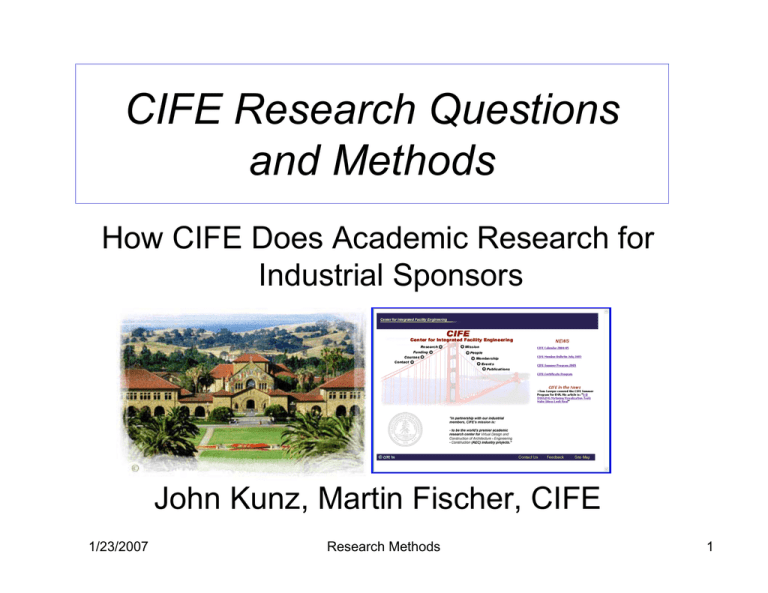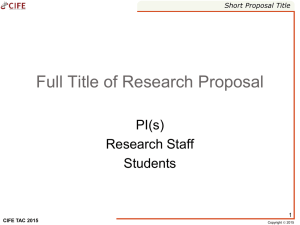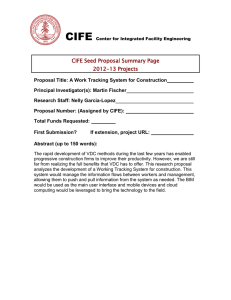CIFE Research Questions and Methods How CIFE Does Academic Research for Industrial Sponsors
advertisement

CIFE Research Questions and Methods How CIFE Does Academic Research for Industrial Sponsors John Kunz, Martin Fischer, CIFE 1/23/2007 Research Methods 1 Construction Management Today • Large unique projects • Lots of – stakeholders – different types of info – Need to relate data – Paper – Time for coordination • Time and cost pressures 1/23/2007 ¾ Needs: implemented, tested theory w/ • Power • Generality Research Methods 2 CIFE research agenda • Broad motivating engineering problems: Engineering practice – – • Has many problems for which a solution is knowable, but the person with the knowledge is not a timely participant Has many aspects of a (repeated, one-off) craft Research questions – – – What fundamental principles characterize civil engineering design and management? How can we operationalize new ones in the computer How how good are they? 1/23/2007 Research Methods 3 CIFE research agenda In 2010, CIFE members • Operate with a strategic plan to implement VDC broadly and will manage by public and explicit modelbased process metrics in latency, safety, quality, schedule, cost and sustainability; • Use Integration of VDC confidently and serve >= 5 business purposes on >=10 major projects/year, e.g., architecture, safety, schedule, space use, energy; • Pilot Automation stage of VDC and automate >30% of routine design and construction activity (wrt 2006 baseline) on > 2 pilot projects/year; and • Staff each project with four VDC trained engineers 1/23/2007 Research Methods 4 CIFE research agenda • Research methods – Careful observation of practice – Computational models of products and processes • Symbolic (non-numeric) • Graphical (4D, Gantt, tables, many specialized views) – Carefully designed validation studies to show evidence of power and generality • Demo that does not break not a mouse • Every good engineer solves hard problems; solving a hard problem is not a mouse • “One mouse is no mice” 1/23/2007 Research Methods 5 CIFE “Horseshoe” Research Method Observed Problem Intuition Theoretical POD Research Methods Research Questions R Tasks: • Theory • Model • Test Predicted Impact Claimed Contributions Validation Results Legend: Leads to 1/23/2007 Research Methods Compare 6 CIFE “Horseshoe” Research Method Observed Problem Metrics (performance), scope (domain) Generality Intuition Theoretical POD Einstein: The only real valuable thing is intuition. Power Research MethodsTestable? Research Questions R Tasks: • Theory • Model • Test Evidence? Predicted Impact Impact 1/23/2007 Claimed Contributions Validation Results Legend: Intellectual Merit Research Methods Leads to Compare 7 Example of Horseshoe in Use Ryan Orr Observed Problem It takes firms many years to evolve a good strategy. What are they learning? Recommends a concrete OD strategy & show that not all strategies are appropriate for all firms. Predicted Impact 1/23/2007 Theoretical POD/ Gap RQs Data Source (1) What strategies do firms use? (2) How do they select these strategies? (1) Case studies w. 3 firms: Kone, Fluor, Hines (2) Asia data (Melin quote about deep understanding) '<- Identifies framework to describe environment> -(1) Recognize set of strategies that firms adopt - (2) Implies a KBV contingency approach to strategy <- Actors, scripts, set, props> - (1) Strategies: incr. KS, decr. KD, incr. except handling, knowl. integration - (2) Strategy = F(EMB, KD) (1) GT (2) Inference <copy the paper b/w US & Canada> Contribution Findings Data Analysis/Presentation - Lack an integrated theoretical framework for why firms adopt different entry & staffing strategies. - Literature tells us strategy selection is discretionary. - Classic mgmt theory has been overlooked. Research Methods 8 Agenda • Observations and Intuitions • What: Research Questions • How: • Examples • Properties – Research Methods • Conclusions 1/23/2007 Research Methods 9 Example-1: Observation Sheryl Staub-French Hard to (re)estimate costs Ì Wall Height: 8’ → 10.5’ Ì Wall Rating: Unrated → Fire-Rated Description QTY uom Metal Stud Wall, Type A Prod. Rate Res. Costs Total Cost (using Crew C-1) Description QTY uom Prod. Rate Res. Costs Total Cost Metal Stud Wall (Crew C-1 & Rolling Scaffolding) Install Metal Stud 1895 LF 4.3 lf/hr $6,000 $6,474 Hang Drywall 5040 SF 65 sf/hr $6,978 $8,037 Apply Tape 5040 SF 45 sf/hr $8,960 $9,464 Install Insulation 2520 SF 100 sf/hr $1,890 $3,024 Install Metal Stud 1550 LF 6.9 lf/hr $3,125 $3,513 Hang Drywall 3840 SF 65 sf/hr $5,317 $6,123 Apply Tape 3840 SF 45 sf/hr $6,827 $7,211 Framing for Openings 6 EA 75 sf/hr $450 $476 $2,304 Frame Wall-Beam Intersec 12 EA 1 hr/ea $540 $552 Apply Fire Caulking 48 LF 40 lf/hr $54 $222 240 LF 60 lf/hr $180 $180 10 Install Insulation Framing for Openings 1/23/2007 1920 SF 100 sf/hr $1,440 6 EA 75 sf/hr $450 $476 Research Methods Cut Drywall Intuition: Features drive costs Features <Objects ActionsResources> Component Features -- Property Set -- Feature Set Legend Instance 1/23/2007 Of Impacts Type Of Intersection Features Cost Macro Features • • • • Area Bending Radius Bottom Elevation Curved • • • • Dimension Change • Penetrations Direction Change • Wall-Beam Intersection Grouping(Similarity) • Wall-Countertop Connections Openings Research Methods • • • • Fire-rating • Thickness Fire-rated • Top Elevation Height • Width Length 11 Research questions, theory 1. How do product features in a building product model affect construction costs? 2. How can the relationship between product features and construction cost be formalized in computer models? 3. How can reasoning mechanisms leverage the representation in (2) to automatically generate cost-loaded and resource-loaded activities? Sheryl Staub-French, 19 December 2001 1/23/2007 Research Methods 12 What? How? What: Staub-French created – Feature and cost ontology (i.e., vocabulary in computer) – Model of effects of feature changes on costs How: – Observe: e.g., Hathaway project – Model and analyze results – Validate, e.g., charrette, realistic example 1/23/2007 Research Methods 13 Research methods: Example-1 • Graphical product model • Symbolic product model • Symbolic process model (Cost analysis procedure) • Retrospective, charrette studies Component Features <F> and/or <O> Research Methods Actions <A> Subcomponents <O> Resource Specification Resources <R> 1/23/2007 Intersection Features <F> and/or <O> Activities Activity Specification Costs <C> 14 Validation study results: Example-1 Δ Theoretical 1/23/2007 Ideal – ACE Process Research Methods Δ ACE Process – Traditional Process 15 Validation Method: Charrette study • Realistic engineering problem: 1-2 hours for practitioner to “solve” • Two studies, same testers – Conventional method – Experimental method • Measured performance metrics: time, cost, accuracy, completeness, consistency, … • Null hypothesis: Performance same for two methods • Test results provide evidence of power and generality of the feature and relationship representation and associated reasoning method Æ claim that theory of each is a contribution to knowledge 1/23/2007 Research Methods 16 Validation methods • Evidence for power and generality of theory: “milk-stool” consistency Theory Observation 1/23/2007 Research Methods Model Analysis (Simulation) 17 Validation methods • Evidence for power and generality of theory: “milk-stool” consistency Swiss milk stool Theory Observation 1/23/2007 Research Methods Model Analysis (Simulation) 18 Example-2: Observation Chuck Han It is hard to ask: • Does this design comply with building code? • How do you know? 1/23/2007 Research Methods 19 Intuition • Intent is a crucial issue for compliance – Designer: rationale for forms – Code: requirements of forms 1/23/2007 Research Methods 20 Research questions, theory 1. Can a generalized analysis framework be built to support automated architectural building code checking? – based on the design-intent of building code 2. What are the product model issues to support (1) – Considering “IFC” standard – Reformulate IFCs to represent intent Chuck Han, 5 October 1998 1/23/2007 Research Methods 21 Research methods: Example-2 • Graphical product model • Symbolic product model • Symbolic process model (Analysis procedure) • GUI • Retrospective, Intervention studies 1/23/2007 Research Methods 22 What? How? What: Han created computer models of – Process – framework – Product – building; wheelchair How: – Observe: Sunnyvale building permit group – Model and analyze (simulation) results – Validate • Many what-if animations • Stanford career center (intervention study) • Test results provide evidence of power and generality of the analysis framework and intent model Æ claim that theory theory is a contribution to knowledge 1/23/2007 Research Methods 23 Intervention Study Method • Observe engineering case • Predict project performance: time, cost, quality, … – With current plan – Following possible intervention (s) • Intervene - at management discretion • Intervention ⇒ Evidence for “believability” • Small-sample statistics w/o control 1/23/2007 Research Methods 24 Research methods: Example-3 John Haymaker • Graphical product model (CAD) • Formalize a Symbolic Project Model as a Directed Acyclic Graph of formalized dependencies between geometric views • Retrospective validation studies of WDCH 1/23/2007 Research Methods 25 Example-3: 1/23/2007 WDCH Concert Hall Cantilever Test Case Research Methods 26 Cantilevered Ceiling Panels Perspector Graph 1/23/2007 Research Methods 27 Methods: Representation Perspector Perspective Perspective 1/23/2007 Research Methods 28 Methods: Reasoning A Generic Perspector: - Analyzes the source Features in the source Perspective(s) - Constructs dependent Feature(s) in the dependent Perspective - Relates the dependent Feature(s) and source Features(s) 1/23/2007 Research Methods 29 Evidence For Power Deck attachments • Interpretation by staff • Perspector interpretation 1/23/2007 Research Methods 30 Evidence for Power of the Perspective Approach: Deck Attachment Retrospective Test Case field welds 5 ___________~ ___ total attachments 100 Quality Accuracy - Found in test case - Missed in test case Completeness - Amount of detail Time to Specify - To conceptualize - To code Perspectors - To assemble graph to Construct and Integrate - For project - For test case 1/23/2007 WDCH Perspective Approach 0 (shop weld)* 86 (field weld)* 114 2 Comments Significant improvement over current practice is possible. Further improvement possible. Automation could make creating more detail cost-effective. 0 sec. 0 sec. 0 sec. 140 hours no data 10 hrs 200 hrs 120 sec no data 56 secs Research Methods Re-use of Perspectors reduces programming time. Practice can reduce conceptualization time. Once graph is specificed, representations can be constructed quickly. 31 Evidence for generality Perspector method for • Deck Attachments • Cantilever conditions Deck Attachment Perspector Cantilevered Ceiling Panel Perspector 1/23/2007 Research Methods 32 Contributions: Based on evidence of generality and power, Haymaker claims that the underlying mechanisms of his method are a contribution to knowledge, specifically 1. Project Model Ontology: dependencies, views, Features, relationships 2. Perspector: reasoning to formally construct a new Perspective from other Perspectives 3. Graph Manager: 1/23/2007 Research Methods 33 (Empirical) Validation methods Validation study methods: 1 2 3 • Retrospective test case(s) • “Stress” test 9 99 • Engineering test cases 9 99 • Prospective (engineering) test case(s) 9 • Laboratory study - Charrette method • Field intervention study 1/23/2007 Research Methods 9 34 Summary • Observations: – Engineering practice still has many aspects of a craft – Careful observation of practice can inform and test research • • • Intuitions: – Engineering Principles can guide practice – Implementing principles in computer can lead to testable theoretical models Research questions: – What fundamental principles characterize civil engineering design and management? – How can we operationalize new ones in the computer – How how good are they? Build Theory: – Processes (e.g., estimate costs, check ADA, plan, create reasoning, …) – Products (Buildings, components, systems), • • Model: Object-oriented symbolic and graphical models of products and processes Validation to show evidence of power and generality: – Many CIFE Ph.D. projects – Integration into CEE curriculum: DCI, CEE 100, 111, 222, 241, 242, 243 – Other Stanford departments: CS, Medicine, Symbolic Systems 1/23/2007 Research Methods 35 Conclusions about Validation • Serious validation studies are a realistic objective for university research • Validation motivates students • Skills – – – – – 1/23/2007 Define measurable performance objectives Observe engineering practice Collect data: Formal instrument Analyze data Interpret results Research Methods 36 Skills for success • Good engineer: design, analyze, manage • Research methods • Communication – Written/Oral – Programming – Colleagues, sponsors, stakeholders • Ability to identify, find examples in the chaos of practice, propose “gold standard” methods • Integrated use of quick-response, careful analysis, reflection 1/23/2007 Research Methods 37 Research: Benefits for Students • Real engineering problems • Synthesize academic, work experience • Methods apply to big questions: – What fundamental principles characterize civil engineering design and management? – How can we operationalize new ones in the computer – How how good are they? • Research methods necessary for careers in practice & research • Interesting • Support 1/23/2007 Research Methods 38 Research: Benefits to Industry • Industry suggests problems – Helps identify big, pre-competitive problems • University perspective adds value – Broad (“integrated”) – Theoretical: consistent, repeatable, exportable processes – Modern methods • Unique opportunity to address hard problems – Focused effort of gifted graduate students working on industrial-class problems • Results have been of interest – – – – – Algorithms (e.g., pipe routing, construction planning) Applications (e.g., org analysis, 4D) Methods (e.g., OOP, 4D, testing, POP, ICE) Successful evangelists within companies (Informal) benchmark evaluation of company processes wrt global best practices 1/23/2007 Research Methods 39 Research Program Status • Research questions 9 What fundamental principles characterize civil engineering design and management? 9 How can we operationalize new ones in the computer 9 How how good are they? • Research methods 9 Careful observation of practice 9 Symbolic (non-numeric) computer models of products and processes 9 Evidence of power and generality 1/23/2007 Research Methods 40 Research Program Status Progress • Practice: small, but real (first VDC users meeting in DC!) • Academic: – Questions and methods now well-validated by CIFE research since 1988, especially last 10 years – CIFE still lives, spawns new competition – CIFE methods now part of Stanford CEE culture: DCI, CEE 100, 111, 222, 241, 242, 243, … – External recognition: “CIFE is the premier academic center for VDC research” – External influence: VDC, validation now real issues 1/23/2007 Research Methods 41 Ph.D. student research seminar • Cifephdstudents -- Ph.D. student research seminar: • cee320 – CIFE Seminar • Sign up for both at lists.stanford.edu 1/23/2007 Research Methods 42

